Bosnia journals 2024,
Journal #5:
With Hajrija
Čobo at Mehorić; Visiting Robert Oroz in Fojnica
2024 Journal
index
Introduction: Meeting the environmental activists
Journal 1:
Ozren is Not for Sale
Journal 2: Pecka
and vicinity: biologists on front line; scandal of coal
Journal 3: The
Pliva River, from the headwaters to the Jajce waterfalls
Journal 4: Coal in Ugljevik; Lithium on Mt. Majevica
Journal 5: With Hajrija Čobo at Mehorić;
Visiting Robert Oroz in Fojnica
Previous journals and articles
To contact Peter in response to these reports or any
of his articles,
click here.
|
Towards the end
of my stay in Bosnia, I visited Hajrija Čobo. I had written about her fight
against environmental destruction in my
essay published in the spring of 2024. A native of Kakanj, Hajrija is a high
school English teacher, but is also trained as an attorney with degrees both in
criminal law and in environmental crime. This background, combined with her
persistence and positive outlook, makes her a strong opponent to the network of
corporate operators and domestic and international officials who are
collaborating to raid Bosnia's natural riches without regard for the
environment.
The company Adriatic Metals opened a mine at Rupice in the hills east of Kakanj,
not far from Vareš. The water supply for the city of Kakanj comes directly from
those hills, and is thereby immediately affected by the mining activity. In the
past couple of years. Hajrija worked to expose the damage that Adriatic Metals
had already caused through clear-cutting, careless dumping of concrete waste,
and poisoning by heavy metals from the mining operation. She and her colleagues
put up a fierce fight, but the mine was opened in early 2024.
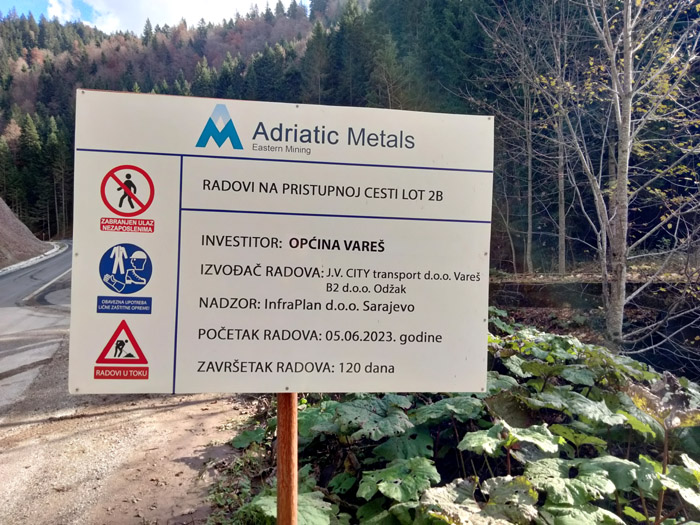
Hajrija picked me
up at the Kakanj bus station, greeting me with a friendly smile. We drove
through the town on the way up into the surrounding hills. Kakanj is plagued by
the presence of a coal power plant fed by nearby coal mines. Pollution from that
plant is compounded by dust from the local concrete factory, making Kakanj's
atmosphere grey and gritty.
We drove north through the historic town of Kraljeva Sutjeska, the home of a
Franciscan monastery established in the 14th century. Beyond this city we
started seeing the ruins of houses bombed during the 1990s war. In this part of
central Bosnia, government forces dominated by Bosniaks took the upper hand, and
many indigenous Croats were displaced. Some returned, but the devastated houses
are evidence that return was far from complete. Hajrija told me, "In the city,
people of all ethnicities protected each other during the war, but it was not so
in the villages."
Higher up in the hills, we ascended Lipničko Brdo, near the village of Lipnica.
From a viewpoint, we faintly saw Bobovac far below, and Mt. Zvijezda on the
horizon to the east of Vareš. Bobovac, now in ruins, was a medieval fortress and
home to the Bosnian royalty before the 15th-century Ottoman conquest.
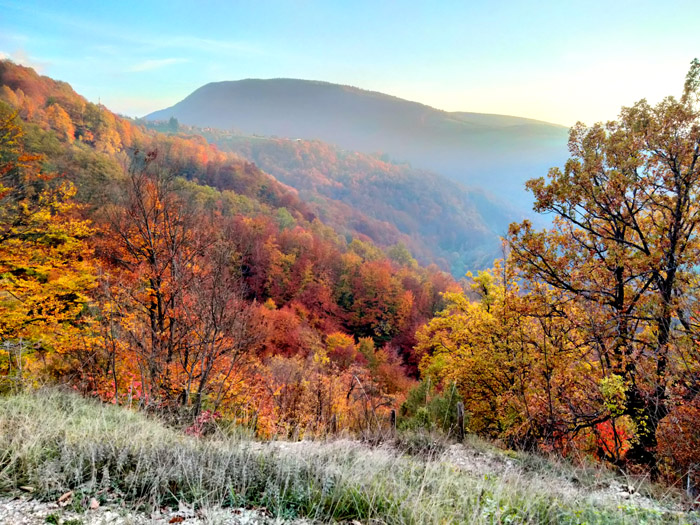
View of Mehorić
looking
towards
Mt.
Zvijezda
The statistic of 262 rivers in a country smaller than West Virginia is dazzling.
But a guided tour of the mountains between Kakanj and Vareš will make you a
believer. There is the Trstionica, the main river coming down from the hills and
joining the River Bosna south of Kakanj. There are the Boriva, the Bukovica, and
numerous tributaries. At many turns in the road we crossed another of these.
One region between Kakanj and Vareš is called Mehorić, home of the headwaters of
the Boriva and the Trstionica. Activists in the region are calling for Mehorić
to be preserved as a Nature Park, and in 2022 founded the organization Park
prirode Trstionica i Boriva—Nature Park Trstionica and Boriva. With Hajrija
as its representative, the group acts as a watchdog on all potential violations
of the environment.
Hajrija told me that in the Central Bosnia Canon's Spatial Plan, the entire
area, from Kraljeva Sutjeska on up to Mehorić, is designated as a Nature Park.
"To date, it is not implemented," she said. "Instead, we got the mine. The
Spatial Plan means that there is supposed to be a high level of protection; the
mine should not have happened. So, the Canton is in conflict with itself."
In the fall of 2023 the municipal assembly of Kakanj unanimously passed an
initiative
calling for the establishment of a protected zone around the upper Trstionica
River and the Bukovica, declaring that this area is "unique in its valuable
natural biodiversity, sources of pure drinking water, the Boriva and Trstionica
Rivers, as well as the priceless national monuments that are found between
Kraljeva Sutjeska all the way to the primeval forests of the Trstionica."
In the
last few years Adriatic Metals continued to dump mining waste into an illicit
landfill; constructed a concrete plant in the middle of the forest near a river;
"accidentally" clearcut a large section of forest near Rupice mine; and turned a
modest hiking path into a paved road. Members of Hajrija's
group monitored these activities and fought back where they were able. They
succeeded in having the deforested area replanted, and Adriatic Metals was
compelled to remove its polluting concrete plant from the forest.
I asked Hajrija what ore was coming out of the mines. She replied, "Lead, zinc,
and barite. But this is all very questionable. On the London and Vienna stock
markets they are saying there is silver. There are also stories of lithium and
uranium."
In the midst of Adriatic Metals' preparation to work the mine at Rupice, the
Federation's Ministry of Agriculture, Water Management and Forestry scandalously
granted the company "temporary" permission to exploit state-owned property.
Reacting to this decision, the state-level Attorney General lodged a complaint
with the state-level Constitutional Court.
All of Bosnia-Herzegovina's state-owned land is under a dispute lasting since
the end of the war, and not legally available for disposition by any authority
until the eventual resolution of this conflict. A "Law on the Temporary
Prohibition of Disposal of State Property of Bosnia and Herzegovina" prohibits
the sale or granting of state-owned land until the matter is resolved at the
state level.
This is a sensitive problem, because authorities in the Republika Srpska have
made a regular practice of illicitly selling off state-owned land in crony
fashion to their friends and colleagues. The Federation Ministry's move—clearly
in the interest of profit to Adriatic Metals and its helpers in the Bosnian
government—implicitly validated the RS's flouting of the ban.
Hajrija discussed the ensuing complaint: "Ninety per cent of the Adriatic Metals
concession is on state-owned land. Appealing before the Constitutional Court, we
filed a lawsuit about the use of that land. We won that case; thus, the contract
with Adriatic Metals is invalid."
The Constitutional Court, in July of 2024,
annulled
the Federation Ministry's granting of land use to Adriatic Metals, and it
similarly annulled the privatization of some public property in the Republika
Srpska, on Mt. Jahorina. Within days after this decision, the company's stock
value fell by nearly six per cent.
*
I asked about the safety of the water; Hajrija had earlier announced that
pollution rendered the drinking water for the 40,000-strong population of Kakanj
dangerous. She told me that Vodokom, the water authority, puts chlorine in the
water. "So I'm not worried about pathogens, but about heavy metals," she said. "Vodokom
tested our water for these components, but the results of the tests have not
been made accessible. I received one result that said there is a high level of
cadmium."
Activists from Park Prirode Trstionica i Boriva staged a series of
demonstrations against the mine at Rupice in early 2023. Hajrija told me that
the first demonstration was small, explaining that "there was much fear." But at
the second one, held in June of that year, 300 people attended.
I asked if it was mostly men who were active in the organization, and Hajrija
responded that it was. "Yes, mostly men. They get around, and they get
information. They find out in advance what Adriatic Metals is going to do. They
don't work for the company, but they have friends who do. For example, if we
find out that Adriatic Metals is preparing to enlarge their concession, then we
can work against that. In this way, we managed to prevent an additional 500
hectares from being lost. And they were going create a much larger landfill in
the forest. We appealed against that and won. This could have amounted to
thousands of cubic meters of tailings."
Hajrija further described an on-line protest and revolt against the betonara,
the concrete factory in Mehorić that was constructed near Vrući Potok stream, in
the middle of the woods. It was dumping waste from the factory into the stream,
making the water a milky color. She told me, "Many citizens sent protest
messages to the municipal inspection department via Viber and e-mail in a
24-hour period, on June 17, 2022. Thousands of these messages were sent to their
general address. So when the staff of the department came to work on Monday,
their inboxes were stuffed. They were compelled to document, print, and send all
these messages to the Canton. As a result of our protests, they closed the
betonara on the 20th of June. They had to fix up the land there, and restore it
to its original condition."
In addition to grassroots mobilization, Hajrija has doggedly pursued legal means
to prevent the mining, or at least to reduce the damage perpetrated by Adriatic
Metals. In 2023 she presented a lawsuit to the Bern Convention of the Council of
Europe, a mechanism created to protect natural habitats and wildlife on the
continent. The
lawsuit
denounced the "air, soil, water pollution and harm to ecosystem caused by mining
activities in Vareš." Responding to this complaint, the Secretariat of the Bern
Convention ordered the relevant authorities to prohibit mining activities until
the lawsuit could be resolved.
Meanwhile, in late 2023 Adriatic Metals filed a libel suit against Hajrija for
"spreading false information about the company via the media and damaging its
reputation." The company demanded 2,000 KM (Bosnian marks—about $1300) in
compensation. The case, clearly a form of repression called a "SLAPP suit"
("Strategic lawsuit against public participation), stalled in court for a time.
Hajrija responded to the lawsuit, as she wrote me, by presenting "a pretty nasty
response of 473 pages with evidentiary material against the company, along with
two CDs of proof."
The company took three months to study this response, and then requested to
withdraw its complaint. Hajrija refused to accept withdrawal of the lawsuit. She
proposed that the plaintiff waive the claim, and that the court deliver a
finding based on that waiver according to the court's understanding of the law.
Alternatively, she proposed, the court could allow the dispute to proceed to its
conclusion. The court followed the latter alternative, and scheduled a
preliminary hearing.
As it happened, in late June of 2024 the court rejected the plaintiff's request,
and Hajrija was cleared: of libeling Adriatic Metals, of having to pay court
costs, of having to apologize, and of having to pay the 2,000 KM fine.
Along with this victory, as noted above, Hajrija and her fellow conservationists
forced Adriatic Metals and associated companies to remove the concrete factory
in the woods, and to restore a deforested area.
There are various words for Hajrija; one would be "formidable."
Hajrija took me into the mountains, as close as we could get to the operations
of the mining company. She showed me the place where the Vrući Potok stream
flowed into the Trstionica. Earlier, I had seen photographs of this tributary,
clouded and milky. Today, it was clear water. Adriatic Metals has taken measures
to clean up its excavation processes and divert polluting byproducts.
Hajrija spread her arms and said, "I am satisfied." I was a bit surprised—with a
multi-million dollar adversary, I would expect her sense of victory to be a
fleeting thing. But Hajrija and her community know that they must not sleep
soundly. The mining companies are more polite to her than they used to be, she
told me. But they will not relent in their drive to expand their mining
operation, which is sure to be accompanied by ever greater pollution.
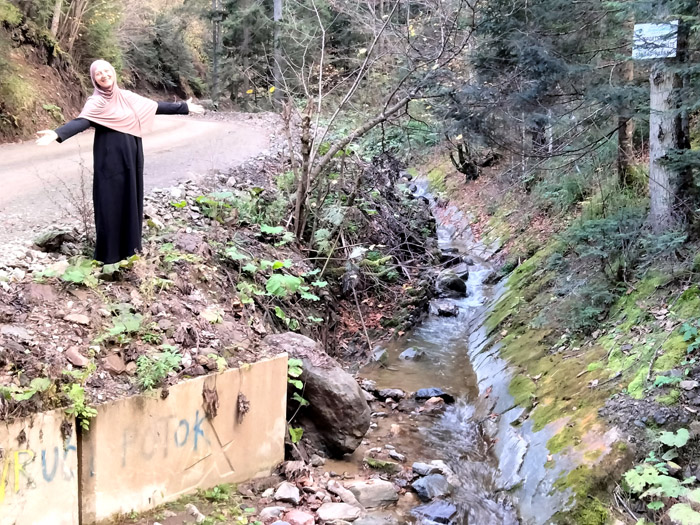
Hajrıja
Čobo at
Vrući Potok
For one last excursion, I traveled to the town of Fojnica, west of Kiseljak in
central Bosnia. There, I met the river conservation activist Robert Oroz, who
lives in the village of Luke, south of the town.
Before the 1990s war, central Bosnia was a patchwork of ethnic communities
living together and beside each other. The demographic map had been compared to
a leopard's spots. Then during the war, homogenization took place, if I can
describe the horror of murder and displacement that way. Most Serbs left or were
driven out, and ended up across the entity boundary in the Republika Srpska. And
most mixed Croat-Bosniak communities were separated, leaving concentrations of
each ethnicity apart from each other throughout the region.
Before the war, Fojnica municipality was predominantly Croat- and Bosniak-populated,
with the proportion of Croats slightly less than that of the Bosniaks. The 2013
census shows that after the war, the overall population of the municipality had
been reduced by about 25%, leaving a majority of Bosniaks (62%) and a reduced,
but not insignificant, proportion of Croats (30%).
Robert Oroz is an electrical engineer, but he is well known around central
Bosnia as a dedicated and respected advocate for protection of the rivers. I
arrived at his village, Luke, at a poignant time, since severe flooding had
taken place there, as well as in several other parts of the country, less than a
month earlier. The wreckage Robert showed me in and around his village was
alarming, with many houses swamped or significantly damaged. Three people lost
their lives. In Donja Jablanica, about 90 kilometers away, much greater damage
had taken place (see my blog entry
here),
with 19 people killed.
For a couple of hours, Robert drove me through Luke and up into the hills,
telling me
about widespread
abuse of the environment, the causes of flooding, and the threat of dam
construction in many areas. He mentioned dams being constructed in places all
the way from Sućeska in the southeast, to locations on the Neretva in
Herzegovina, to places nearer to home. You can examine a shockingly dense map of
dams planned, in construction, or in function throughout Bosnia-Herzegovina
here.
"In
2006 they built small dams, the Jezernica [west of Fojnica] and one at Kozica,
13 kilometers north of Fojnica"
Robert told me, "and they built a dam at Radava in 2016. That one was never put
into operation; there was not enough water pressure to make it work. There are
waterfalls at Kozice. A company from Slovenia built a dam above those
waterfalls, and it uses 70% of the water."
"More than 500 dams were planned in Bosnia-Herzegovina," Robert continued. "To
date, over 120 have been built, 71 in the Federation, and 52 in the RS. There
are nearly 40 here in Central Bosnia Canton alone. I'm not a builder by
profession, but since I'm an electrical engineer, I understand these things. The
dams have been presented as something gentle, like a water mill—but they are
not; in the damage they do to the environment, they are a monster."
Robert outlined the history of resistance to the dams in his area and beyond.
"We were afraid of what would happen with these dams. We started fighting them
in 2006. The first dam, near Luke, was started in 2009. We blocked it for three
months. The builders, a company from Travnik,
gave up, but they came back in 2012. At that time, we blocked the project with
our bodies and with cars for 325 days, day and night. We would sound the alarm
when workers came out."
I asked how activists in the community contacted each other in those moments.
Robert answered, "We would send SMS messages—in those days, we still did not
have social networking. Later, in 2017, these things were easier. Now, we have
several people who help by keeping tabs on what's going on. When there is a
need, we are able to organize the raja—people in our circle—to mobilize."
During the action to block the dam, Robert said, "we were afraid of them
destroying the environment and causing flooding. At first, it was unpopular when
we fought the dam, and it was difficult to get to the media. But soon, the whole
village came out against it. Among other things, we engaged lawyers. We had
three resources in our fight: Our bodies; lawyers; and the media.
The dam at Luke was never built, and Robert's colleagues, as he has written me,
"succeeded through court proceedings to have the concessions withdrawn for this
and the other mini-dams planned for the Fojnica area—all eight of them."
"I have been at almost all the protests, for over 15 years," Robert told me. "We
have shared our experiences further afield. There was a project to build a dam
at Kruščica, in Vitez municipality a hundred kilometers north of Fojnica. There,
in August of 2017, there was resistance, led by women, to a projected dam. The
Canton police physically attacked the women who were protesting there—even
against pregnant women. That resistance lasted for 505 days."
The campaign at Kruščica
stands out for
the heroism and persistence of the women who placed their bodies on the line.
Private investors had received permits to build two hydropower plants on the
river by the town of the same name. Faced with protest, the investor held a
"public hearing" that was not open to the public.
In the summer of 2017 women blocked a bridge over the river; men stood to
one side, assuming that the police would refrain from violence against the
women. However, the police attacked and put more than two dozen citizens in the
hospital, arresting
22 women and one man. But resistance only grew; 200 to 300 people were
actively involved in blocking the bridge.
The blockade at
Kruščica
lasted over 500 days. Combined with legal action and appeals, the resistance
resulted in the revocation of permits for the two dams in 2020.
However, the concessions for the dams were not cancelled, and the struggle
continued in the courts—until the Federation outlawed construction of new mini-hydrodams.
Describing further resistance to dams around Bosnia, Robert mentioned one of the
most prominent—and somewhat successful—campaigns. "The biggest protest of all
was on the Neretvica, in 2020-2021.
[The state-owned
company]
Elektroprivreda had planned 15 dams. We prevented that. In 2020 we succeeded to
have a law passed in the Federation that prohibits the construction of any
mini-dams in the Federation, up to 10 megawatts.
"In 2016, the Koalicija za zaštitu rijeka BiH (the Coalition for the
Protection of the Rivers of Bosnia-Herzegovina) was created, with 740
non-governmental organizations involved. The Coalition is the nicest thing that
has happened since the war. There are some problems, because some people do not
like the fact that we are working together. I am sad because of this. I don't
have the answer. Everywhere in Bosnia, there is some tactic to divide people.
But we are all [Croats and Bosniaks in the Federation] together in the
protests."
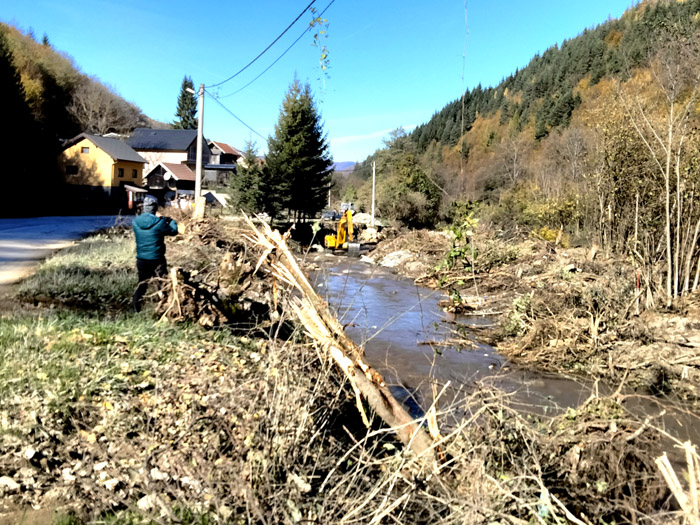
Repairing damage to the river, above Luke
After a drive upstream along the Željeznica River, we returned to Robert's
village and surveyed the damage resulting from the flooding of early October.
There were houses tilted on their foundations, some of them half-covered with
mud. The banks of the rivers were clogged with branches, mud, and debris.
Earth-moving machines were beginning to restore those spaces.
Robert told me that Luke was at the epicenter of the flooding in this area.
Across the street from his house, he showed me the mudflats by the riverbank.
All of his former holdings were buried. "I had a fishpond; there were otters. I
had an orchard too, and a vegetable garden. It is all gone."
Citizens in the flooded areas are clear that their adversary is not nature, but
the authorities who mismanage it. Above Donja Jablanica there was a neglected
rock quarry, the debris of which tumbled down onto the village. State-owned and
private companies have logged forests without replenishing them, leaving the
slopes open to landslides. The same result comes from neglect after forest
fires.
Robert criticized treatment of the river ecosystems: "The river behaves like a
living organism. It fills up with debris, and then that gets blown downstream in
a flood. Now the workers are moving that debris back up-country, but away from
the riverbanks. It is not ok to touch the riverbanks. They should not be private
property; they are made for all of us, and for the animals. Children play on
these rivers; people swim, and fish. My generation did this, and before us, and
it should be the same after us.
"There should be strahopoštovanje [awe, respect] for nature. Now, it has
shown its power."
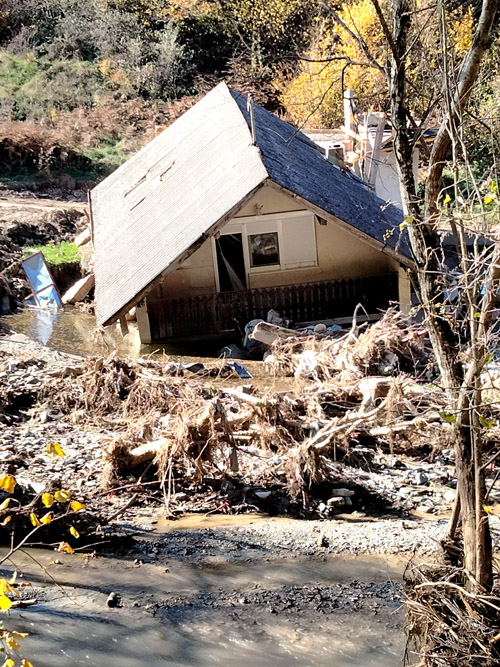
A house at Luke, submerged by the flood
In mountainous central Bosnia, mining is as much of a threat as are the dams.
Robert gave me a bit of a history tour: "The Romans mined gold at Bakovići
[near
present-day Luke].
The Austro-Hungarians, and then the British, mined here as well, all the way up
to World War II. In the Tito era, they mined barite and iron here, until the
1970s."
To demonstrate the long-term poisoning resulting from mining, Robert took me to
an empty, weedy field hard by Fojnica town. There had been a mine there, he told
me. "The mine was closed 80 years ago, but nothing grows here. There is an
acidic runoff from the minerals." Robert showed me pyrite in the soil, and
orange-colored puddles in the flats. "A British company had the concession here,
mining gold and silver. There is slag, refuse from the project. These impurities
now flow into the Željeznica river. Local people tried to plant something here,
but it didn't grow. No grass grows there," he said. "Nothing is alive in the
creek running with orange water.
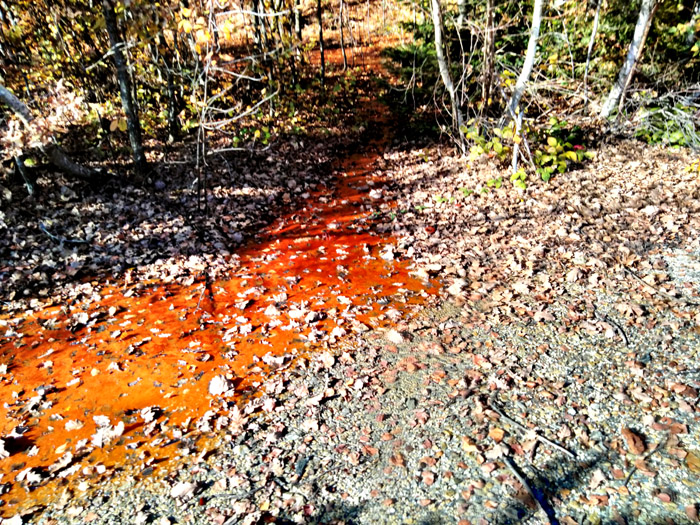
Poisonous runoff from a mine closed 80 years ago
"In 2017 and 2018 the Sarajevo company BBM tried to reopen the mine. The company
is involved in heavy construction and engineering: highways, bridges. They had
the concession to reopen this mine. We blocked it because, among other things,
we feared poisoning from the use of cyanide in the mining process. We have
experience with that; it is one of the strongest poisons.
"The local politicians who support all these projects have no razum—they
are unreasonable. Bosnia receives a pittance of the income from its natural
resources. Our resources are given away for negligible amounts. After the
war, the entire social property of Bosnia was pillaged.
First, the state-owned property was privatized, and then the natural resources.
That includes the forests and the water, and then the minerals."
I asked, "Looking forward what struggles do you see developing?" Robert
answered, "We have to protect the rivers, the mines, the riverbanks, and prevent
illegal building. Forestry is the least regulated sector. Since 2009, the
Federation has not had a forestry law. Companies just do whatever they want. It
is a situation of lawlessness."
Considering that a company was allowed to build a dam just upstream from the
waterfall at
Kozica,
I would have to agree.